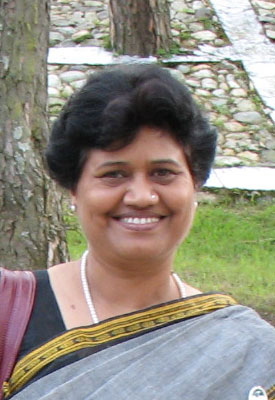 Fruits of working in tandem with the Nature?Ecologists attribute the huge damage witnessed in Uttarakhand during devastating floods to large-scale plundering of nature by mafias and the policymakers.? Though, the relief and rescue operation is in full swing, the statistics citing damage and loss of lives are skyrocketing every moment. Amidst the cry for relief and politics on disaster, there is something which gives a sense of relief and sets a precedent to imitate—the damage is minimal in the areas where the efforts of reviving the forests were going on. It happened in Gomukh region where more than 10,000 trees of some rare spices like Bhojpatra have been planted. The credit for this wonderful work goes to leading mountaineer Dr Harshwanti Bisht. Planted in 1996 in very challenging climate, at an altitude of 12,500 ft, these trees are now taller than man and proved highly useful in preserving the nature, which is being ruined by both the mafias and the policymakers for years.
Fruits of working in tandem with the Nature?Ecologists attribute the huge damage witnessed in Uttarakhand during devastating floods to large-scale plundering of nature by mafias and the policymakers.? Though, the relief and rescue operation is in full swing, the statistics citing damage and loss of lives are skyrocketing every moment. Amidst the cry for relief and politics on disaster, there is something which gives a sense of relief and sets a precedent to imitate—the damage is minimal in the areas where the efforts of reviving the forests were going on. It happened in Gomukh region where more than 10,000 trees of some rare spices like Bhojpatra have been planted. The credit for this wonderful work goes to leading mountaineer Dr Harshwanti Bisht. Planted in 1996 in very challenging climate, at an altitude of 12,500 ft, these trees are now taller than man and proved highly useful in preserving the nature, which is being ruined by both the mafias and the policymakers for years.
Pramod Kumar
The nature’s fury witnessed in Uttarakhand last week is a lesson for man to understand in proper terms how costly the unmindful exploitation of nature can prove. It also leaves a lesson that if we preserve the nature, our future is safe. It has been witnessed in the same Uttarakhand where the nature caused terrible havoc. In Gangotri-Gomukh region, Arjuna awardee mountaineer Dr Harshwanti Bisht has revived a forest by planting rare Bhojpatra trees (Betula utilis) and even after the floods the damage in the region is minimal. This forest was basically ruined by the tourists and mafias. Dr Bisht’s transformation from a mountaineer to a conservationist began in 1989 when she conducted a study to assess the impacts of tourism and pilgrimage on the ecology of the region. The work of tree plantation began in 1996 and till now she has revived more than 10,000 trees.
Harshwanti participated in the Mount Everest expedition, in 1984. She closely saw the widespread destruction of nature in Uttarakhand. Therefore, instead of pursuing her career in mountaineering she focussed on reviving the nature in the region. During the study in 1989 she found how the accumulation of huge amounts of garbage, mushrooming of dhabas for pilgrims and large-scale deforestation were threatening the fragile ecosystem. After the study, she along with her fellow mountaineer Rattan Singh Chauhan, first conducted several environmental awareness campaigns and garbage collection expeditions in the area and then took up afforestation activities.
A member of 1984 Everest expedition, she found that Betula utilis was the ideal species for plantation at the altitude of 12,500 feet. In 1993, after getting permission from the Forest Department, she established a nursery at Chirbasa, at a height of 11,700 feet. It is just nine km from Gangotri. Later, she got permission from the department for afforestation on a 12 hectare area at Bhojbasa, inside the Gangotri National Park. In 1996, 2.5 hectare land was taken up and 2,500 saplings were planted at Bhojbasa, while in the second phase (1997-2000) over 10,000 saplings were planted on an area of 5.5 hectares. Most notably, at each plantation site post plantation activities like manuring, gap plantations were carried out for ten years. Barbed wire fencing was also constructed to protect the plantations.
The rugged topography and extremely cold climatic conditions made the work very difficult and the progress was slow. The cold dry alpine desert conditions also severely hamper the survival and growth of the plants—merely 6 to 8 inches per annum with a survival rate of 50-55 per cent. Therefore, it was an uphill task. Apart from grappling with such forces of the nature, Dr Bisht also had to battle with the oppressive tactics of some forest officials. “In 2004, Rattan Singh and myself were falsely implicated in a criminal case by the forest department, Uttarkashi, and later in 2006 eviction notices were issued to us. But finally, the court quashed the case and acquitted us from all the false allegations put forth by the Forest Department. We are still fighting all odds to make this constructive environmental work a success, she said. In this way the task was much challenging than climbing any mountain peak,” she says. But in spite of all odds, her hard work reaped rich dividends.
This is the first successful plantation of Bhojpatra in the Indian Himalayas. “Covering over two decades of sustained efforts, our experiences can hopefully help others who are struggling to protect fragile alpine environments while balancing the benefits that religious and adventure tourism accrue to the local economy of mountain communities. Our progress in re-establishing birch trees can be of particular assistance to those seeking information on eco-rehabilitation in dry high altitude climates.”
Apart from Bhojpatra Dr Bisht also planted Bhangil (Salix babilonica) and Pahari Pipal (Populous ciliate) trees. Simultaneously, she also cultivated medicinal plants like Kutki (Aconitum heterophyllum), Atis (Picrorhiza kurroa), Archa (Rheum emodi) and Salam Panja (Orchis habemioides).
Commenting on the recent devastation, Dr Bisht who is also Principal of Government Degree College, Doiwala, Dehradun says, “The lesson of this disaster is that we should not allow unplanned tourism and pilgrimage in this region. People have constructed hostels even in highly sensitive zones. The commercialism is literally spoiling the devbhoomi. Not only Kedarnath, wherever you go you find the same picture. The Badrinath Temple is heavily crowded. Similar is the scene in Gangotri. Everywhere, the people seem hungry for making money. Just because of that we are not thinking where to do what. Everywhere concrete forests are being constructed and for it we have encroached not only the pilgrimage places, but also the rivers, pasture land and all the places sensitive for ecological balance.”
Many people talk of preserving the nature, but how much is materialised on the ground always remains a question. But Dr Bisht has shown how to curb the future calamities and also to ensure
safe future for coming generations.














Comments